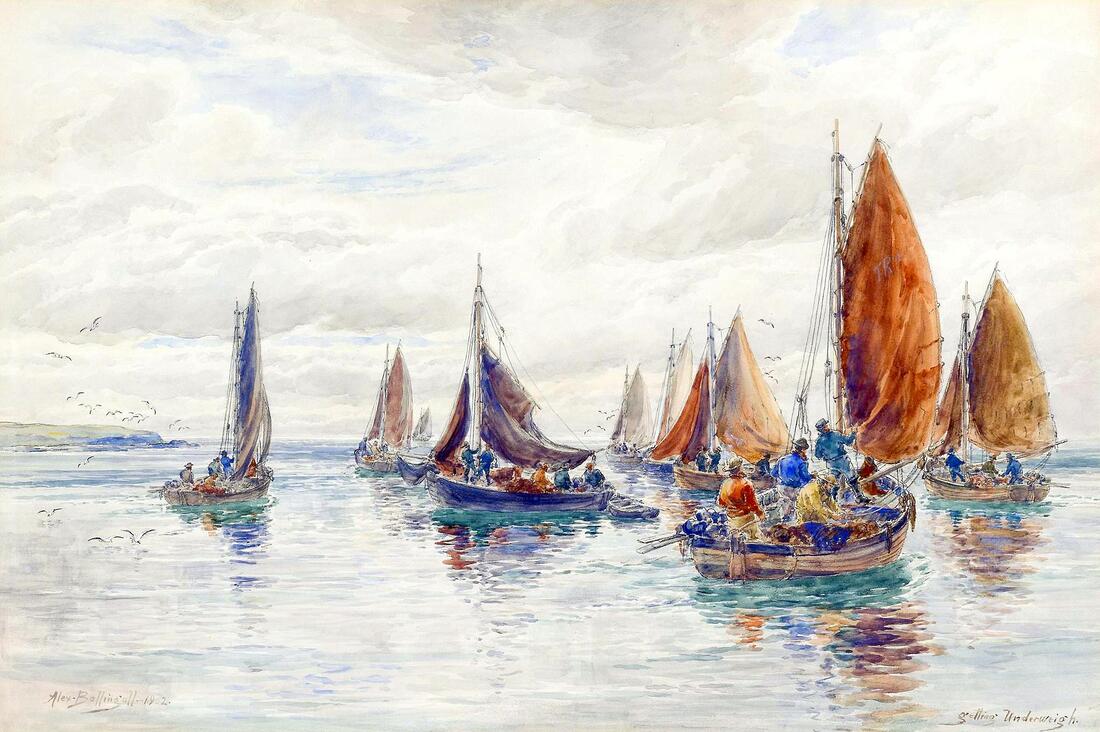The fascinating painting above, entitled Home from the North Sea, is the work of Alexander Ballingall , the Largo-born painter and brother of engraver William Ballingall. This piece depicts the return home of the Largo fishing fleet in the 1890s. The registration of the boat with the most prominent sail is KY 478 - Annie Johnston. This fishing craft was built in 1880 in Anstruther but spent several years in Montrose before being bought by Largo's David Gillies in 1889. Annie Johnston was part of Largo's fleet for over a decade before being sold to Shetland in 1901. The colourful scene is a welcome contrast to the usual black and white images of fishing vessels from this era. The reddish-brown colour of the sails is the result of the white fabric being treated (or barked) with tar to make them more weather-proof.
Multiple boats from Largo would tend to leave in groups for a lengthy trip. Some trips might head up further north, off Aberdeen or Shetland, or perhaps south to fishing grounds around Yarmouth depending upon the time of year. Children would often be allowed time out of school to see their fathers off. Ships' biscuits would be given out before the boats sailed away. Eventually, word would be sent home of their planned return, so that families could watch with anticipation for their safe arrival back home.
The kind of scene depicted in the painting, with a crowded pier, would have once been a frequent one, where wives and children greeted the fishermen with joy and relief. Note the man in the foreground presenting his daughter with the gift of a doll. Her mother, who is dressed in traditional fishwife clothes looks on with affection. Gifts brought back from far afield trips would be the main presents given in the year.
Other men, perhaps unmarried, busy themselves sorting and unloading their gear. Some of these nets and other gear may well have been taken over to the other side of the Keil to be dried and stored in and around the Net House. Back home, the washing of the men's clothes would take several days. Six boats feature in this painting. Given the date of late 1890s, other vessels may have included the Forget-Me-Not, Sultan, Ocean Bride, Osprey and Jane and Minnie. Alexander Ballingall painted many scenes around Largo pier, harbour and coast but also depicted other locations. Below is an 1881 painting by Alexander named Troubled Waters, Stonehaven which illustrates a winter herring trip, with stormy waves crashing around the harbour.
Alexander Ballingall was born in Largo in 1847, son of weaver William Ballingall and his wife Jean Wilson. One of several brothers and two sisters, like many of his siblings Alexander had a creative streak. While at the age of 14 he was working as a weaver like his father, he was destined to follow more in the footsteps of his elder brother, William the artist and engraver. By the time of the 1871 census, in his early twenties, Alexander was living in Edinburgh with his brother and his family and both brothers were working as engravers. They were based at Cockburn Street, just off the Royal Mile. Over the years, Alexander seems to have progressed more into painting than engraving and in 1879 he exhibited at Kirkcaldy Fine Art Exhibition with a painting entitled "Newhaven Harbour".
In 1881 he first exhibited at the Royal Scottish Academy. In the census that year Alexander was described as a 'landscape painter', still based in Edinburgh but now in Newington. The 9 March Dundee Advertiser described his 1886 work at the RSA as "always forcible and thorough in his sketches of sea-faring life". By 1891, he was married to silversmith's daughter Marion Wilson and living at 99 Montgomery Street off Leith Walk, now described as 'Artist - marine and figure'. The same year his RSA exhibits were, according to the Midlothian Journal of 17 April, "three crisp, clever realistic sea-scapes". One of those is the work shown above entitled Now then lads! All together. The newspaper noted the "caller seaside breeziness" and "the anatomy of the pullers...carefully studied, and sea, and rocks, and sky are as usual well done."
In contrast to the painting at the top of the post depicting the fishermen's return from sea, the artwork above is entitled Getting Underweigh. This shows the fishing fleet setting off on calm seas and dates to 1902. By this time Alexander's wife had died (in 1898 from tuberculosis). The 1901 census had noted him as 'Artist - marine and landscape'. His works did include overseas landscapes, including Venice, as well as many Scottish coastal scenes, including such locations as Buckhaven, Pittenweem, Dunbar and Greenock. By 1911, now aged 64, Alexander was still living off Leith Walk and was slightly differently described as 'Artist (marine and architectural)'.
Alexander died on 30 November 1913, at the age of 67 at Bangour Village Hospital in West Lothian. He was buried at Upper Largo cemetery with parents, William Ballingall (a keen amateur astronomer) and Jean Wilson. The gravestone, although now in poor repair, has many interesting features, including a globe (now displaced), a shining star, a moon, a coastal setting sun, a sand timer and a sun dial. This unusual and eye-catching memorial is fitting for such a creative family many of whom keenly observed the world around them, and beyond.








 RSS Feed
RSS Feed
